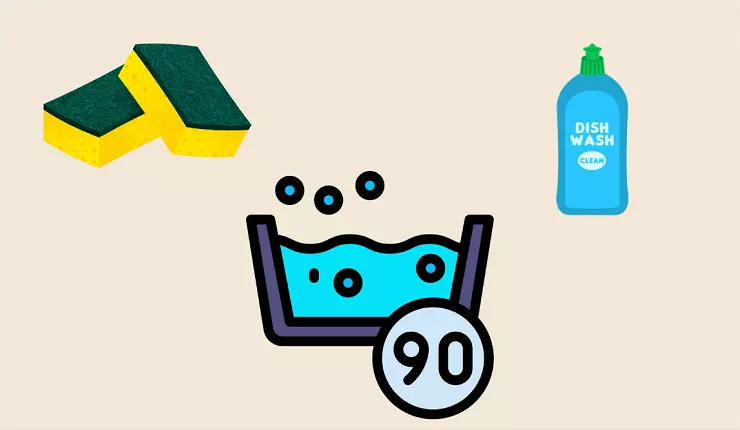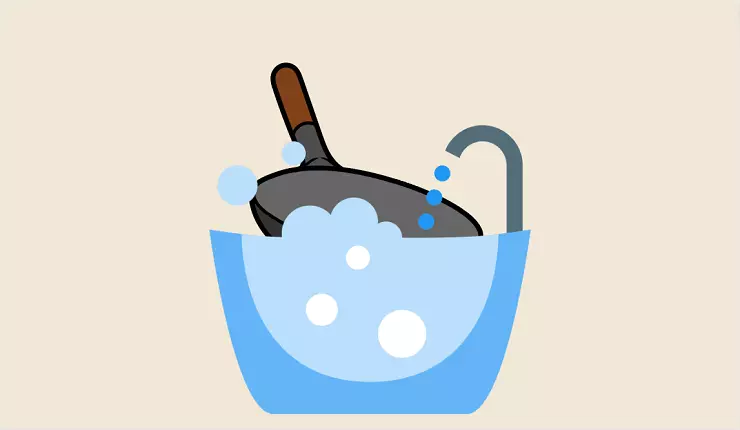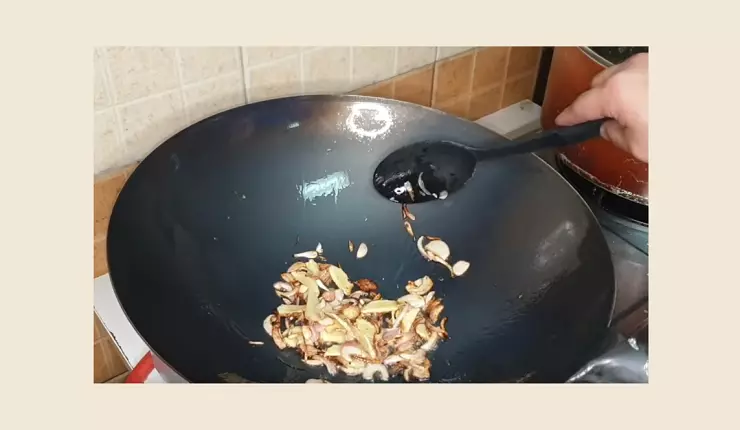I love using a good wok to cook my meals, but I have noticed one of my woks is worn out. In fact, the Teflon coating is peeling off the surface, which is not ideal for cooking.
By the way, Teflon coating is also known as a non-stick coating.
I do not want any of the loose coating to wind up in my food, but I’m not ready to toss out my cookware either. Luckily, a friend informed me that I can remove the coating from the product altogether.
Once I found out I could remove the coating, I decided to check out various websites, videos and forums to find out how others were removing the coating. Of course, I had to take note of all the information I found to make a guide for my readers.
I also realized during my research how easy it is to remove the coating, and I realized there are several methods for removing the coating from your cookware.
If anyone is wondering how easy it is to remove the Teflon coating from a nonstick baking sheet – answer =VERY 😱
— Melanie Thornton (@Melanie18T) October 1, 2012
As you read through my guide, you can learn:
- How to remove non-stick coating from wok
- Whether it is safe to remove the coating
- Why it is necessary to remove the coating from your cookware
- How to season your cookware after removing the coating
- When you should finally replace the cookware
One fact I have learned about woks is that they are made of various materials. According to Dexam,
The wok is usually crafted either from cast iron or carbon steel though you can also find aluminium and stainless steel designs. The most popular designs tend to be made from carbon steel as it’s lightweight and nonstick and is also very affordable.
You can learn more about woks and how to remove the coating by reading through my guide.
Table of Contents
- 1. Why You Might Need to Remove Non-Stick Coating →
- 1.1. Why Woks with Non-Stick Coating Do Not Work for Stir-Fry? →
- 2. Is It Safe to Remove the Non-Stick Coating? →
- 3. The Methods for Removing the Non-Stick Coating →
- 3.1. Removing the Non-Stick Coating with Dish Detergent, Hot Water and a Scouring Pad →
- 3.2. Soaking the Cookware to Remove the Non-Stick Coating →
- 3.3. Using Metal Scrubbers to Remove Non-Stick Coating →
- 3.4. Using Baking Soda →
- 3.5. Using Abrasive Blasting with Aluminum Oxide Blast Media →
- 3.6. Using High Heat →
- 3.7. Using Sandpaper →
- 3.8. Using an Angle Grinder →
- 3.9. Sanding with Aluminum Oxide →
- 3.10. Using Walnut Shells →
- 4. How to Use a Wok Without Non-Stick Coating →
- 4.1. How to Properly Season Your Wok →
- 5. When It Is Time to Replace the Wok →
- 6. Useful Resources →
Learn How to Remove Non-Stick Coating from Wok in My Guide
Before I get to the methods of removing the non-stick coating, I want to share some information on why it is necessary and whether it is safe to remove it.
Why You Might Need to Remove Non-Stick Coating
It is important to avoid using cookware if the coating is peeling off because it can become a hazard to yourself and others.
The peeled coating may cause the food to stick to the bottom of the pan, and it may not be released evenly as you cook your meal. Therefore, the coating may get mixed into your food.
Can you imagine consuming pieces of Teflon coating? This is dangerous because these pieces are not meant to be ingested.
According to WokAll,
I am not recommending using the pan if its coating is pacing off. It becomes so trying to cook. Either you extract the non-stick coating from cookware, or you can buy a new one.
I agree with this statement. You need to either remove the coating altogether or buy a new product, but you should never use any cookware if the coating is peeling.
Why Woks with Non-Stick Coating Do Not Work for Stir-Fry?
Did you know that a wok with non-stick coating is not ideal for stir-fry meals? In this video, Wok with Tak explains why he encourages his students to use a different wok for stir-fry.
Later in my guide, you are going to learn how to season your cookware with oil. You can learn more about wok oil by clicking here.
Is It Safe to Remove the Non-Stick Coating?
It is understandable to wonder if it is safe to remove the non-stick coating. I wondered that myself because I wanted to avoid risking my health or damaging my cookware.
The answer is yes, it is safe to remove the coating from your cookware. In fact, cooking without extra oil is a great way to prepare healthy meals.
Of course, the non-stick coating also makes it easier to cook because the food does stick to the surface.
As a reminder, it is not safe to use cookware if the coating is peeling.
The Methods for Removing the Non-Stick Coating
I have found several methods for removing the coating from your cookware.
If you decide to replace your cookware altogether, you want to ensure you are choosing the right product for your kitchen. For example, it is important to choose the best wok for a glass top stove.
Now, it is time to explore the various methods on how to remove non-stick coating from wok.
Removing the Non-Stick Coating with Dish Detergent, Hot Water and a Scouring Pad

- Pour a half an inch layer of dish detergent onto the surface of the cookware.
- Soak the cookware in hot water for several hours or overnight.
- Rinse off the dish detergent, and add baking soda to help with the process.
- Use the scouring pad to scrub off the rest of the coating.
- There are additional steps for excess coating, but you do need to wear thick rubber gloves and safety goggles for each step.
- Pour drain opening gel on the surface.
- Let the cookware sit for at least two days in a space that is open or well-ventilated, but be sure to keep it away from other people and pets.
- Use a heavy-duty scouring pad and elbow grease to remove the rest of the coating.
You can also find methods using hot water, dish detergent and scouring pads to remove burnt food from your cookware.
Soaking the Cookware to Remove the Non-Stick Coating

- Place your cookware in the sink with half an inch of dishwasher soap and boiling water.
- Allow the cookware to soak in the mixture for about 20 to 24 hours. If you need to use the sink, you may need to soak your cookware in a large pot or pan.
- After soaking the wok, sprinkle a little baking soda on the surface.
- Use a scouring pad to scrub off the coating.
- Repeat the previous steps until the coating has been completely removed.
Using Metal Scrubbers to Remove Non-Stick Coating

- Use a metal scrubber and baking soda to remove the coating.
- If needed, you can sprinkle more baking soda on the surface.
Using Baking Soda
- Wash the cookware with warm water and a mild dish detergent to remove any excess food.
- Create a paste using equal parts baking soda and water.
- Apply the paste to the surface of the cookware, and scrub the surface with a non-abrasive brush or sponge.
- Repeat the previous steps as needed until the coating has been removed.
In this video, DMS Experts shares a method of removing the non-stick coating from cookware. The method includes baking soda, dishwashing liquid, vinegar and sandpaper.
Using Abrasive Blasting with Aluminum Oxide Blast Media
When learning how to remove non-stick coating from wok, there are two methods of using Aluminum Oxide Blast Media.
- The first method is to sandblast or grit blast the surface with the Aluminum Oxide Blast Media.
- The second method is to hire a professional for the job. This is ideal if you do not feel comfortable doing this method yourself.
Using High Heat
- Place the cookware on the stove over high heat. You may need to set it to over 500 degrees Fahrenheit.
- If necessary, continue doing this for several days, but be sure to keep an eye on the stove.
- Eventually, the high heat will remove the rest of the coating.
Using Sandpaper

- Wear rubber gloves to protect your hands from the sandpaper.
- If needed, cut the sandpaper into a smaller piece to fit your cookware.
- Use elbow grease to rub the surface with the sandpaper.
- Use a cloth to remove the loose coating from the surface.
- Repeat steps three and four until all the coating has been removed.
- Rub the sandpaper on the cookware clockwise and counter-clockwise to smooth the surface.
- Wash your cookware with dish detergent and rinse it off.
You can also find methods for cleaning a rusty wok, which offers top-notch maintenance for your cookware.
Using an Angle Grinder

- Put on safety gloves, goggles and a mask for protection.
- Attach a wire cup brush to an angle grinder.
- Use the angle grinder with the wire cup brush to remove all the coating.
- Once the coating has been removed, wipe the cookware off and apply a metal polish.
- On the angle grinder, replace the wire cup brush with a polishing disk.
- Use the angle grinder and polishing disk to polish the surface.
- When you are finished, remove the metal polish with a sponge and any dish detergent that can remove oil or grease.
- Rinse the cookware in clean water and let it dry.
Sanding with Aluminum Oxide
To remove the non-stick coating, sand the surface of the cookware with Aluminum Oxide.
Just like the Aluminum Oxide Blast Media, you may need to hire a professional for this method. Aluminum Oxide is used for more professional or bigger projects.
Using Walnut Shells

- You can also sandblast the coating off with walnut shells. This can be used as an alternative to Aluminum Oxide.
- Another method is to hire a professional sandblasting company to remove the coating with walnut shells.
Walnut shells can remove the coating without damaging the aluminum surface of your cookware.
Using Vinegar and Baking Soda
- Boil some water in your cookware.
- Once the water boils, carefully move your cookware to the sink.
- Add one cup of vinegar and two tablespoons of baking soda to your cookware.
- Allow the cookware and the mixture of vinegar and baking soda to cool for several minutes.
- Scrub the coating off the surface with a sponge.
- Remember to remove all excess coating before putting your cookware away.
How to Use a Wok Without Non-Stick Coating
Once you learn how to remove non-stick coating from wok, you want to ensure you season your cookware to create a non-stick surface.

- Preheat your cookware for about two minutes.
- Pour two or three tablespoons of oil into your cookware, spreading it throughout the surface. Examples are coconut, grapeseed or flaxseed oil, but you can also look into actual wok oil for the process.
- You can also add diced onions and salt to the mixture, but the onions are only for seasoning your cookware and not for consumption.
- Place the cookware on the stove until smoke starts rising from the oil.
- Turn off the stove once you notice the smoke, and give your cookware time to cool.
- After the cookware has cooled down, use a paper towel or cloth to wipe off the excess oil.
For maximum results, repeat the previous steps two to three times.
How to Properly Season Your Wok
It is important to season your wok to keep your food from sticking to the surface. In this video, It’s An Awesome Food shares the steps for properly seasoning your cookware.
In addition to maintaining your cookware, you also need to practice kitchen safety. In this article, I explore how hot a toaster gets to keep you safe while cooking.
When It Is Time to Replace the Wok
There comes a time when it is necessary to replace your cookware altogether.
Speaking of pots & pans – always remove food from them before you cut into it. Cutting on the pan can scratch it & the nonstick coating can get into your food 🤢
If you have a scratched up pot/pan- throw it out. Marshalls/Target/Kohls (w/ coupons) have great replacements
— (773) 202-JESS (@773202JESS) February 14, 2022
Remember, excess coating mixing into your food can pose a health risk because you may ingest those pieces.
To quote Easy Kitchen Guide,
Even if you remove the non stick coating from your old worn pan, it requires more oil to cook the food that is unhealthy.
If you do not feel comfortable removing the coating and seasoning your cookware, it is okay to toss it and purchase a replacement. You can find woks made of various materials at affordable prices.
You also want to replace your cookware if the surface is too scratched or the coating is not coming off with any of the above methods.
If you are replacing your cookware, you want to ensure you are choosing the right product for your stove. You can find my list of the best woks for a glass top stove by clicking here.
Useful Recourses
- Stainless Steel Vs Nonstick Vs Ceramic Cookware: Which Should You Choose? →
- What Is Nonstick Cooking Spray? →
- The Best Bundt Pan →
Choose Your Method of Removing the Non-Stick Coating
There are several tips on how to remove non-stick coating from wok, which makes it easier to find a method that works for you. You can use water, high heat or common household products, or you can hire a professional to blast the coating off your cookware.
Once you remove all the non-stick coating from your cookware, you can season and continue using it for your favorite meals.
- Lava Rocks Vs. Fire Glass – What Is Better for a Fire Pit? - November 15, 2023
- How to Light a Propane/Gas Fire Pit with a Manual or Electronic Ignition System - November 8, 2023
- How Long Does a Propane Tank Last for a Fire Pit - October 9, 2023


Hi, I have a question for you please help, I power washed the coating off my non stick pan, then I brought the pot to a boil n added cream of tartar n baking soda to the water once it came to a boil and it turned the silver pan grayish color , can I get it back to silver color again?
Hello! Of course, I’d be happy to help! It sounds like the cream of tartar and baking soda mixture might have reacted with the pan’s surface, causing the discoloration. To potentially restore the silver color to your non-stick pan, you can try the following steps:
Start by creating a paste using baking soda and water. Gently scrub the discolored areas of the pan using a soft cloth or non-abrasive sponge. This might help to lift off any residues or discoloration caused by the reaction.
Another approach is to mix equal parts of white vinegar and water in a bowl. Heat the solution until it’s warm (not boiling) and then soak the pan in it for about 15-20 minutes. After soaking, gently scrub the pan again with a non-abrasive sponge.
You could also consider using a cleaning product like Bar Keeper’s Friend, which is often effective at removing tough stains and discolorations from various surfaces. Just make sure to follow the product’s instructions for use on cookware and test it on a small, inconspicuous area first.
If the discoloration persists or worsens despite these efforts, it might be a good idea to reach out to the manufacturer of the pan. They could provide specific recommendations for restoring the color or addressing the issue.
Remember that non-stick pans have a delicate surface, so it’s important to use gentle cleaning methods and avoid abrasive materials that could further damage the pan. Always refer to the care instructions provided by the manufacturer to ensure you’re treating the pan properly.